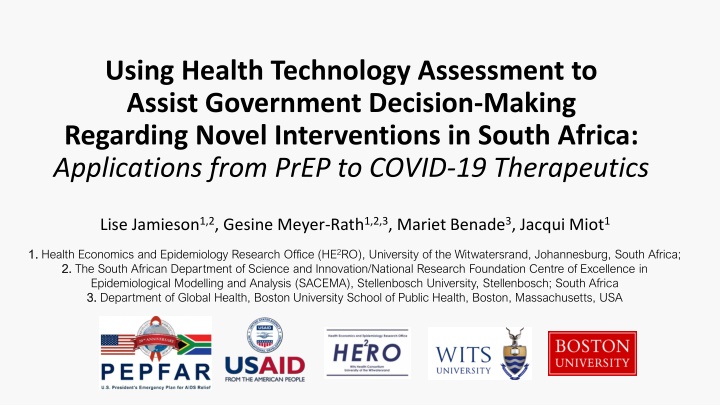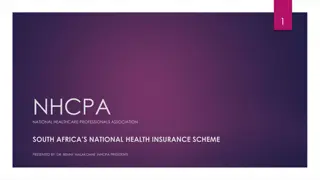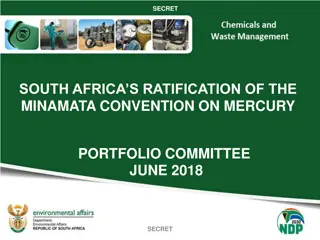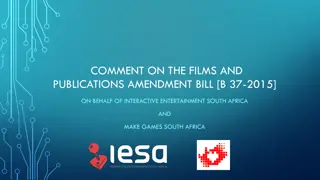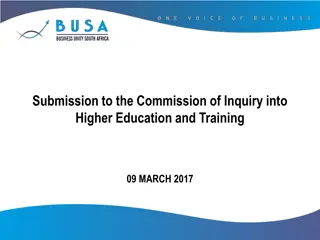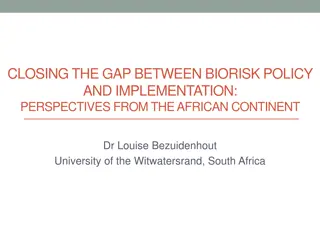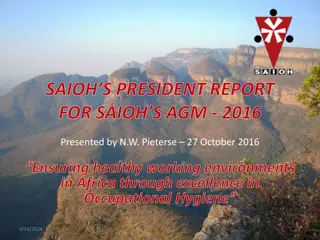Enhancing Government Decision-Making with Health Technology Assessment in South Africa
Health Technology Assessment (HTA) plays a crucial role in informing policy and funding decisions in South Africa, particularly in the context of the National Health Insurance (NHI) aiming for universal healthcare coverage. This multidisciplinary process assesses the value and impact of health technologies, guiding analysts in evidence submission for the Essential Medicines List Committee. The involvement of the Health Economic and Epidemiology Research Office (HE2RO) in HTA for the National Department of Health enhances decision-making and capacity-building efforts, emphasizing independence and interaction with key committees. The HTA methods guide outlines assessment tiers and considerations for evaluating novel interventions, ensuring thorough analysis for informed decision-making.
Download Presentation

Please find below an Image/Link to download the presentation.
The content on the website is provided AS IS for your information and personal use only. It may not be sold, licensed, or shared on other websites without obtaining consent from the author.If you encounter any issues during the download, it is possible that the publisher has removed the file from their server.
You are allowed to download the files provided on this website for personal or commercial use, subject to the condition that they are used lawfully. All files are the property of their respective owners.
The content on the website is provided AS IS for your information and personal use only. It may not be sold, licensed, or shared on other websites without obtaining consent from the author.
E N D
Presentation Transcript
Using Health Technology Assessment to Assist Government Decision-Making Regarding Novel Interventions in South Africa: Applications from PrEP to COVID-19 Therapeutics Lise Jamieson1,2, Gesine Meyer-Rath1,2,3, Mariet Benade3, Jacqui Miot1 1. 1. Health Economics and Epidemiology Research Office (HE2RO), University of the Witwatersrand, Johannesburg, South Africa; 2. 2. The South African Department of Science and Innovation/National Research Foundation Centre of Excellence in Epidemiological Modelling and Analysis (SACEMA), Stellenbosch University, Stellenbosch; South Africa 3. 3. Department of Global Health, Boston University School of Public Health, Boston, Massachusetts, USA
Context National Health Insurance (NHI) aims to provide universal healthcare coverage for all Significant step towards achieving equitable healthcare access Health Technology Assessment (HTA) provides critical evidence to support policy and funding decisions Multidisciplinary process to assess the value and impact of health technologies Especially important in the context of NHI Recently developed HTA framework and methods guide aims to assist analysts in preparation for evidence submission to South Africa s Essential Medicines List Committee promote comparability across medicine assessments
Context The Health Economic and Epidemiology Research Office (HE2RO) has increased their involvement in doing HTA for National Department of Health (NDOH) Assist in decision making Build capacity generally for HTA Independence important Direct, regular interaction with National Essential Medicine List Committee (NEMLC) and Affordable Medicine Director (AMD) The order of the slides reflects the chronological order of the evaluations and the learnings as we went along.
HTA methods guide: tiers of assessment Consider: Rapid systematic review Systematic review Clinical effect on patients? yes Technical Report: Medicine details PICOs Review and critical appraisal of clinical evidence Pharmaceutical costs Summary of other HTA agency decisions Equity impact considerations Social values considerations Feasibility considerations Additional analysis required? Consider: Cost-comparison analysis Budget impact analysis Cost implications for the health sector? yes Compared to existing treatments within South African context, is there uncertainty terms of: Consider: Rapid review of economic evaluations Basic costs-effectiveness analysis Comprehensive cost- effectiveness analysis Cost effectiveness? yes Any other factors relevant to the decision requiring additional analysis/ evidence? Consider Bespoke analysis (expert- informed scope development) yes
COVID-19 therapeutics: Remdesivir for C-19 Context:Analysis mostly done before shared with NEMLC What: broad-spectrum antiviral medication Target population: COVID-19 patients Efficacy data: 11 placebo-controlled RCTs Outcome: all-cause mortality (no difference); hospitalisation (1 RCT reported 72% relative risk reduction)
COVID-19 therapeutics: Remdesivir for C-19 Methods: an excel model comparing remdesivir to dexamethasone NEMLC recommendation: Remdesivir not recommended for the treatment of non- hospitalised patients with COVID-19 Intravenous medication impractical, access limited Medication expensive ($270/course) NB. The clinical evidence for remdesivir eventually showed that there was no significant benefit and so the need for the evaluation was a moot point
COVID-19 therapeutics: Tocilizumab for C-19 Context: At the peak of the waves before the vaccine had been finalised and was available What: immunosuppressive drug Target population: hospitalised ICU COVID-19 patients on oxygen/ventilatory assistance Efficacy data: 12 placebo-controlled RCTs Outcome: all-cause mortality (12% relative risk reduction)
COVID-19 therapeutics: Tocilizumab for C-19 Methods: Excel model with inputs from the national SA COVID-19 model, comparing impact at different levels of need for ICU care Budget impact analysis based on estimates for a 3rd and 4th wave NEMLC recommendation: Tocilizumab not recommended due to current unaffordability (>$350/patient treated) Concerns regarding availability even once approved; global demand was huge Questionable if savings would be realised more likely that ICU bed would still be occupied demand would outstrip bed availability as this it was the peak of the wave
COVID-19 therapeutics: Baricitinib for C-19 Context: vaccine program was ramping up and a high degree of seroprevalence through previous infections What: immunomodulatory medication Target population: hospitalised COVID-19 patients on oxygen/ventilation/ECMO Efficacy data: Marconi 2021, Horby 2022, Ely 2022 (3 placebo-controlled RCTs) Outcome: mechanical ventilation (13% relative reduction) all-cause mortality (25% relative reduction) or
COVID-19 therapeutics: Baricitinib for C-19 Methods: Excel model; hospitalisation/mortality inputs ICER ZAR 15,488/life year gained based admission and life expectancy Budget impact analysis based on estimates for a 4th wave did not consider savings from reduced hospital length of stay or progression to ventilation NEMLC recommendation: NEML MAC recommends the use of baricitinib in hospitalised patients with confirmed COVID-19 who require supplemental oxygen on age at
COVID-19 therapeutics: Molnupiravir for C-19 Context: Vaccine program well established; high level of seroprevalence through previous infections What: antiviral medication inhibits virus RNA replication Target population: mild/moderate COVID-19 cases Efficacy data: MOVe-OUT phase II/III trial Outcome: hospitalisation/death; 3% absolute risk reduction (69% relative risk reduction) in molnupiravir vs placebo by day 29
COVID-19 therapeutics: Molnupiravir for C-19 Methods: Excel model with inputs from the national SA COVID-19 model on expected mild/moderate cases in coming months Cost of hospitalisation (Edoka 2022); Length of hospital stay (DATCOV, NICD) NEMLC recommendation Molnupiravir is not recommended. Feasibility issues needs to be used within 5 days of symptom onset; non-availability in SA; not for use in pregnancy; no studies in unvaccinated NB. NEMLC did not end up using our evaluation because the pandemic had changed significantly
HIV prevention: Cabotegravir (CAB-LA) Context: South Africa - high HIV burden; large market for pre-exposure prophylaxis (PrEP) (oral PrEP uptake 20% of global market) What: long-acting injectable antiretroviral drug Target population: HIV negative high risk individuals Efficacy data: HPTN 083, 084 trials Outcome: 66%-89% in preventing HIV compared to oral PrEP; estimated 95% efficacy in preventing HIV compared to no PrEP
HIV prevention: Cabotegravir (CAB-LA) Methods: HIV transmission model was required (Thembisa); 20-year time horizon Comparator: standard of care oral PrEP Target populations: AGYW, ABYM, FSW, MSM Assumptions for coverage (medium/high) and duration on CAB-LA (same as oral PrEP or longer) Costing: ingredients based, resource use based on oral PrEP programme Cost includes lowest staff cadre, demand creation and training Threshold analysis: price of CAB-LA injection vs. oral PrEP?
HIV prevention: Cabotegravir (CAB-LA) Results: CAB-LA has 3- to 5-fold increase in averting HIV infections vs. scaling up oral PrEP, over 20 years Threshold analysis: CAB-LA to cost $9-15/injection to be as cost-effective as oral PrEP NEMLC could not recommend CAB-LA SAHPRA approval pending at the time Affordable price available (price negotiations still underway) Need more evidence that excludes an oral CAB lead-in
Lessons learnt NB: economic evaluations are only part of the decision making process Other factors taken into consideration (NEMLC uses Evidence-to- Decision EtD Framework) Answer the questions that NEMLC ask and not just do an academic exercise Rapid evaluations means that rapid answers were needed simple evaluations quicker However, some questions required more complex evaluations and in the case of COVID-19 there either wasn t time or data unavailable
Lessons learnt Decisions changed depending on where in the timing of the COVID-19 pandemic the evaluation was done E.g. Vaccine, increased seroprevalence hospital admissions slowed budget impact analysis reduced + availability of medicines changed Economic evaluation, costing and budget impact analysis played a critical role in the decision making Building capacity within country for HTA essential Ensure the sustainability and effectiveness of the process Adapt methodologies/analyses to local context Enhance continuity of assessment for future reviews
